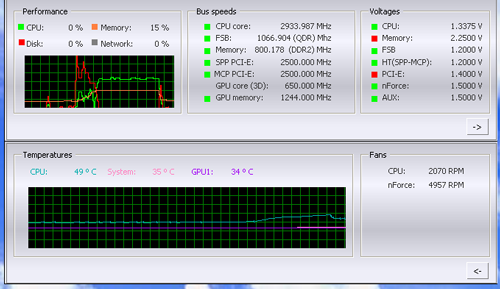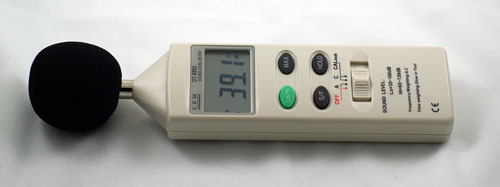Tuniq Tower 120: Air Cooling to the Max
by Wesley Fink on January 15, 2007 12:01 AM EST- Posted in
- Cases/Cooling/PSUs
CPU Cooling Test Configuration
A primary requirement for any cooling test bed is a reliable utility for measuring CPU temperature and fan speed. The utility also must be usable while other programs are running so the impact of stress testing can be assessed. It is not really critically important that the temperature measurements be completely accurate, but results must be consistent and repeatable using the same test setup.After assessing a number of Intel 975/965 and NVIDIA 680i motherboards the decision was reached to use the NVIDIA 680i as the cooling test bed. This was primarily based on the excellent temperature measurement utility, NVIDIA Monitor, which is part of the nTune program.

NVIDIA Monitor has a drop-down pane for temperature measurement which reports CPU, System, and GPU measurement. At this point we will concentrate primarily on CPU temperature with listings of system temps for reference. In addition to the real-time temperature measurement, NVIDIA Monitor also has a logging feature which can record temperature in a file in standard increments (we selected every 4 seconds). This allows recording of temperatures during testing and play back, for example, of stress test results that can then be examined when the stress tests are completed. There is also the handy reference of speeds and voltages in the top pane to confirm the test setup. These factors made NVIDIA Monitor on the 680i the ideal program for evaluating cooling.
Further tests using the program showed results were consistent over the same setup and repeatable under similar conditions. For all of these reasons NVIDIA Monitor on the NVIDIA 680i was used for testing cooling. Other components in the cooling test bed are generally the same as those used in our motherboard and memory test bed:
| Cooling Performance Test Configuration | |
| Processor: | Intel Core 2 Duo X6800 (x2 2.93GHz, 4MB Unified Cache) |
| RAM: | 2x1GB Corsair Dominator PC2-8888 (DDR2-1111) |
| Hard Drive: | Hitachi 250GB SATA2 enabled (16MB Buffer) |
| Video Card: | 1 x EVGA 7900GTX - All Standard Tests |
| Platform Drivers: | NVIDIA 9.53 |
| Video Drivers: | NVIDIA 93.71 |
| CPU Cooling: | Tuniq Tower 120 Intel Stock HSF for X6800 |
| Power Supply: | OCZ PowerStream 520W |
| Motherboard: | EVGA 680i SLI (nVidia 680i) |
| Operating System: | Windows XP Professional SP2 |
| BIOS | Award P23 (12/22/2006) |
The 680i motherboard with NVIDIA Monitor software will allow testing of the cooling efficiency of the cooler under test. We first tested the stock Intel cooler at standard X6800 speed, measuring the CPU temperature at idle and while the CPU was being stressed. We stressed the CPU by running continuous loops of the Far Cry River demo. The same tests were repeated at the highest stable overclock we could achieve with the stock cooler. Stable in this case meant the ability to handle our Far Cry looping for at least 30 minutes.
The same tests were then run on the cooler under test at stock, highest stock cooler OC speed, and the highest OC that could be achieved in the same setup with the cooler being tested. This allows measurement of the cooling efficiency of the test unit compared to stock and the improvement in overclocking capabilities, if any, from using the test cooler.
Noise Levels

In addition to cooling efficiency and overclocking abilities, users shopping for CPU cooling solutions may also be interested in the noise levels of the cooling devices they are considering. Noise levels were measured in various configurations using a C. E. M. DT-8850 Sound Level meter. The C. E. M. meter can measure either A-weighted or C-weighted sound levels. All reported measurements are A-weighted since this is generally considered closer to the way the human ear actually perceives noise.
This meter allows sound level measurements from 35bdB to 130dB with a resolution of 0.1dB and an accuracy of +/- 1.5dB. This is sufficient for our needs in these tests, as measurement starts at the level of a relatively quiet room. Our own test room, with all computers and fans turned off, has a room noise level of 36.4dB. Our procedures for measuring cooling system noise are described on page 6 along with noise results comparing the stock Intel cooler to the Tuniq Tower 120.










50 Comments
View All Comments
kilkennycat - Monday, January 15, 2007 - link
The Tuniq Tower 120 weighs 798grams WITHOUT the fan. Both AMD and intel spec ~ 450g maximum and the first-class coolers in this class, the radial design such as the Zalman 9500 and the very similar new Asus radial design endeavor to minimize the weight while maximizing the cooling. The 9500 is ~ 475 grams and the Asus is ~ 610 grams ( both including the fan). Also, the center of gravity of this cooler is much higher off the motherboard than either of the coolers mentioned, especially when the fan is installed. The only way such a cooler can be used safely if the PC is to be transported anywhere after installation... eg to a LAN party or even moving between rooms... is to extend the mounting points of the cooler directly to the PC case, so that the case becomes the prime resistance against any physical strains on the cooler. Otherwise, torsion on the motherboard in the event of any shock to the cooler parallel to the plane of the motherboard is likely to compromise the integrity of the motherboard any one of a number of really nasty ways .... rupture ball-grid array solder joints, rupture circuit-board vias due to layer separation, pop the solder connections of surface mount components, cause hair-line cracks in rigid components such as surface-mount resistors and capacitors. Such failures almost invariably show up as functional intermittents and impossible to track down. I have personally witnessed similar failures caused by poor mechanical designs involving large unsupported components on professional electronic gear when subjected to standard shock tests.Jedi2155 - Monday, January 15, 2007 - link
I've had this installed in my system and i've already moved it about 3-5 times (Lan parties). I've had no issues so far. It seems stable enough.btwango - Monday, January 15, 2007 - link
798grams? without fan!! i don't think i want that much mass hanging off my mobo.plewis00 - Monday, January 15, 2007 - link
The temperature graphs are a bit funny. You give STOCK, 14 x 266 and then 14 x 1095 and 1114 (which I'm guessing are quad-pumped figures instead). Also maybe it was me but I couldn't figure out if your temperature figures were with the Tuniq running at full or minimum speed, I presume the former.It's a great bit of cooling but given I'm working in a mATX case, I'll never have the fun of trying this kit out.
Googer - Monday, January 15, 2007 - link
Did you forget to add Peltier to the list of cooling options?
Wesley Fink - Monday, January 15, 2007 - link
Peltier, or thermoelectric cooling and heating, operates on the same principal as phase change, but the way cooling is actually accomplished is somewhat different. We added Peltier to our list of the various cooling solutions.DigitalFreak - Monday, January 15, 2007 - link
I want to see the temps with just someone blowing on the heat spreader!Gigahertz19 - Monday, January 15, 2007 - link
I purchased the new Thermaltake Typhoon VX for my Core 2 rig and love it. I have it turned on to the lowest setting and you can't even hear it. Only thing I don't like is the knob to adjust the fan speed is on the HSF so you have to open up your case to adjust it, they should have provided a PCI slot like the Tuniq to adjust fan speed.I read in some review the Typhoon VX is the best, I have the linked saved on my laptop but it comapared the VX to a whole bunch of the air cooling solutions and it performed at the very top. I don't think the review included the Tuniq Tower 120 yet.
Zalman 9700 vs Thermaltake Typhoon VX vs Tuniq Tower 120 for the next review!!! We would truly know what's best!
sadsteve - Monday, January 15, 2007 - link
Hi, very nice review.I was wondering if you monitored the PWMIC and chipset temperatures too. I had a Sonic Tower (another 'vertical fan' HSF) which cooled my processor very well, but my PWMIC and chipset temperatures were quiet high. I switched to a Big Typhoon where the fan blows down on the motherboard. I had pretty much the same CPU temperatures (actually better) but my PWMIC and chipset temperatures dropped 15-20 degrees C. I was able to remove the chipset HSF and replace it with a passive heatsink and still had lower temperatures on the chipset (minus the high pitched fan noise!).
Keep up the good work. I check your site at least once a day (yes, weekends too!).
Thank you.
Wesley Fink - Monday, January 15, 2007 - link
We did not monitor chipset temperatures, but you make a very good point. Our EVGA 680i board uses active cooling on the northbridge. Frankly that 680i fan is so loud we needed to turn it off for all noise measurements. It is only needeed for overclocking, fortunately. The 680i is fine with passive cooling at stock speeds.